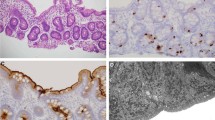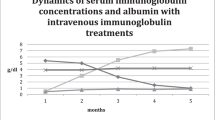Abstract
Tricho-hepato-enteric syndrome (THE-S) is characterized by severe infantile diarrhea, failure to thrive, dysmorphism, woolly hair, and immune or hepatic dysfunction. We report two cases of East Asian descent with THE-S who had remained undiagnosed despite extensive investigations but were diagnosed on whole exome sequencing (WES). Both cases presented with chronic diarrhea, failure to thrive, and recurrent infections. Case 1 had posteriorly rotated low set ears, mild retrognathia, and fine curly hypopigmented hair. She was managed with prolonged total parenteral nutrition and intravenous immunoglobulin infusions. Case 2 had sparse coarse brown hair as well as multiple lentigines and café-au-lait macules. She was managed with amino acid-based formula. For both cases, routine investigations were inconclusive. WES in both cases showed biallelic truncating mutations in TTC37 (c.3507T>G;p.Y1169X and c.3601C>T;p.R1201X in case 1 and c.3507T>G;p.Y1169X and c.154G>T;p.E52X in case 2), suggesting a diagnosis of THE-S.
Conclusion: We present novel mutations in the TTC37 gene in two individuals of East Asian descent with the rare THE-S, detected by WES. Future identification of patients with THE-S and establishing genotype-phenotype correlations will aid in counseling the patients and their families.
What is Known: • Tricho-Hepato-Enteric syndrome (THE-S) is characterized by severe infantile diarrhea, failure to thrive, dysmorphism, woolly hair, and immune or hepatic dysfunction. • Complex patients with diagnostic dilemmas undergo extensive investigations. |
What is New: • This is a report of novel mutations in TTC37 in individuals of East Asian descent. • Whole exome sequencing (WES) can be useful in certain complex cases with diagnostic dilemmas. |



Similar content being viewed by others
Abbreviations
- CID:
-
Combined immunodeficiency
- CMV PCR:
-
Cytomegalovirus
- HSCT:
-
Hematopoietic stem cell transplant
- IVIG infusions:
-
intravenous immunoglobulin
- TPN:
-
Total parenteral nutrition
- THE-S:
-
Tricho-hepato-enteric syndrome
- WES:
-
Whole exome sequencing
References
Abecasis GR, Auton A, Brooks LD, DePristo MA, Durbin RM, Handsaker RE, Kang HM, Marth GT, McVean GA (2012) An integrated map of genetic variation from 1,092 human genomes. Nature 491:56–65. doi:10.1038/nature11632
Biesecker LG, Green RC (2014) Diagnostic clinical genome and exome sequencing. N Engl J Med 370:2418–2425. doi:10.1056/NEJMra1312543
DePristo MA, Banks E, Poplin R, Garimella KV, Maguire JR, Hartl C, Philippakis AA, del Angel G, Rivas MA, Hanna M, McKenna A, Fennell TJ, Kernytsky AM, Sivachenko AY, Cibulskis K, Gabriel SB, Altshuler D, Daly MJ (2011) A framework for variation discovery and genotyping using next-generation DNA sequencing data. Nat Genet 43:491–498. doi:10.1038/ng.806
Egritas O, Dalgic B, Onder M (2009) Tricho-hepato-enteric syndrome presenting with mild colitis. Eur J Pediatr 168:933–935. doi:10.1007/s00431-008-0861-4
Exome Variant Server, NHLBI Exome Sequencing Project (ESP), Seattle, WA (URL: http://evs.gs.washington.edu/EVS/) [1 February, 2015].
Fabre A, Breton A, Coste ME, Colomb V, Dubern B, Lachaux A, Lemale J, Mancini J, Marinier E, Martinez-Vinson C, Peretti N, Perry A, Roquelaure B, Venaille A, Sarles J, Goulet O, Badens C (2014) Syndromic (phenotypic) diarrhoea of infancy/tricho-hepato-enteric syndrome. Arch Dis Child 99:35–38. doi:10.1136/archdischild-2013-304016
Fabre A, Martinez-Vinson C, Goulet O, Badens C (2013) Syndromic diarrhea/Tricho-hepato-enteric syndrome. Orphanet J Rare Dis 8:5. doi:10.1186/1750-1172-8-5
Javed A, Agrawal S, Ng PC (2014) Phen-Gen: combining phenotype and genotype to analyze rare disorders. Nat Methods 11:935–937. doi:10.1038/nmeth.3046
Kammermeier J, Drury S, James CT, Dziubak R, Ocaka L, Elawad M, Beales P, Lench N, Uhlig HH, Bacchelli C, Shah N (2014) Targeted gene panel sequencing in children with very early onset inflammatory bowel disease–evaluation and prospective analysis. J Med Genet 51:748–755. doi:10.1136/jmedgenet-2014-102624
Kotecha UH, Movva S, Puri RD, Verma IC (2012) Trichohepatoenteric syndrome: founder mutation in Asian Indians. Mol Syndromol 3:89–93. doi:10.1159/000339896
Li H, Durbin R (2009) Fast and accurate short read alignment with Burrows-Wheeler transform. Bioinformatics 25:1754–1760. doi:10.1093/bioinformatics/btp324
Monies DM, Rahbeeni Z, Abouelhoda M, Naim EA, Al-Younes B, Meyer BF, Al-Mehaidib A (2015) Expanding phenotypic and allelic heterogeneity of tricho-hepato-enteric syndrome. J Pediatr Gastroenterol Nutr 60:352–356. doi:10.1097/mpg.0000000000000627
Oz-Levi D, Weiss B, Lahad A, Greenberger S, Pode-Shakked B, Somech R, Olender T, Tatarsky P, Marek-Yagel D, Pras E, Anikster Y, Lancet D (2014) Exome sequencing as a differential diagnosis tool: resolving mild trichohepatoenteric syndrome. Clin Genet. doi:10.1111/cge.12494
Rider NL, Boisson B, Jyonouchi S, Hanson EP, Rosenzweig SD, Cassanova JL, Orange JS (2015) Novel TTC37 mutations in a patient with immunodeficiency without diarrhea: extending the phenotype of trichohepatoenteric syndrome. Front Pediatr 3:2. doi:10.3389/fped.2015.00002
Schnekenberg RP, Nemeth AH (2014) Next-generation sequencing in childhood disorders. Arch Dis Child 99:284–290. doi:10.1136/archdischild-2012-302881
Sherry ST, Ward MH, Kholodov M, Baker J, Phan L, Smigielski EM, Sirotkin K (2001) dbSNP: the NCBI database of genetic variation. Nucleic Acids Res 29:308–311
Uhlig HH, Schwerd T, Koletzko S, Shah N, Kammermeier J, Elkadri A, Ouahed J, Wilson DC, Travis SP, Turner D, Klein C, Snapper SB, Muise AM (2014) The diagnostic approach to monogenic very early onset inflammatory bowel disease. Gastroenterology 147(990-1007), e1003. doi:10.1053/j.gastro.2014.07.023
Wang K, Li M, Hakonarson H (2010) ANNOVAR: functional annotation of genetic variants from high-throughput sequencing data. Nucleic Acids Res 38, e164. doi:10.1093/nar/gkq603
Yang Y, Muzny DM, Reid JG, Bainbridge MN, Willis A, Ward PA, Braxton A, Beuten J, Xia F, Niu Z, Hardison M, Person R, Bekheirnia MR, Leduc MS, Kirby A, Pham P, Scull J, Wang M, Ding Y, Plon SE, Lupski JR, Beaudet AL, Gibbs RA, Eng CM (2013) Clinical whole-exome sequencing for the diagnosis of Mendelian disorders. N Engl J Med 369:1502–1511. doi:10.1056/NEJMoa1306555
Acknowledgments
For Case 1, we would like to acknowledge Hong Kong Health and Medical Research Fund (HMRF 01120846 to Lau YL and Yang WL) and The Hong Kong Society for the Relief of Disabled Children and Children’s Cancer Foundation of Hong Kong (to Lau YL) for their support. For Case 2, we would like to acknowledge the research funding sources, KNMRCCGRC001 and KNMRCCGSF4-2 from NMRC, MOH as well as Agency for Science, Technology and Research (A*STAR), Biomedical Research Council. In addition, we would like to acknowledge Pamela Lee, Chan KW, Yang WL, The University of Hong Kong, for data analysis for Case 1; Dr Asif Javed, Genome Institute of Singapore, for his help with Phen-Gen analysis for Case 2, and Dr Maggie Brett, KK Women’s and Children’s Hospital, for Sanger validation of the variants detected in the two cases as well as testing the parents for carrier status.
Author’s contributions
JHC, SSJ, and WKL wrote the initial draft of the manuscript. Each author listed on the manuscript has reviewed the manuscript, approved the submission of this version of the manuscript, and takes full responsibility for the manuscript. All the clinicians (JHC, SSJ, MJAK, EST, AL, CO, KCT, YLL, WKL) were important in data acquisition and interpretation of these cases. The laboratory staff (WLWT, RF, ECT) were involved in data analysis. These two patients had complicated courses that required input from multiple authors.
Ethical statement
This article does not contain any studies with human participants or animals performed by any of the authors. Informed consent is obtained from parents of the cases described.
Conflict of interest
The authors do not have a financial relationship with the organizations that sponsored the study.
Author information
Authors and Affiliations
Corresponding author
Additional information
Communicated by Beat Steinmann
Rights and permissions
About this article
Cite this article
Chong, J.H., Jamuar, S.S., Ong, C. et al. Tricho-hepato-enteric syndrome (THE-S): two cases and review of the literature. Eur J Pediatr 174, 1405–1411 (2015). https://doi.org/10.1007/s00431-015-2563-z
Received:
Revised:
Accepted:
Published:
Issue Date:
DOI: https://doi.org/10.1007/s00431-015-2563-z




